|
Canon
300mm
f2.8 IS L 'Prime' Lens |
In 2009,
I became a member of Edinburgh Zoo and started to alternate visits to
the zoo with my hill walking. I did not own a proper telephoto lens for
wildlife photography so I started to research the lenses available. I
soon began to realise that focal reach was important but if I wanted a
'single' lens solution then it must have a shorter reach and yet through
using a teleconverter or by 'cropping' in software post processing, I
could extend that reach. I figured that there would be certain
limitations in this approach but they would be in the minority. I
reckoned that a 300mm prime telephoto lens would provide the optimum
flexibility and cover most of the shots that I would take. I felt that a
400mm lens was to long and I could miss the intermediate shots.
This article
covers the use of a 300mm 'Pro' FX Lens on a DX DSLR body, problems with
my wildlife photographic technique and other 300mm lens/camera options
for more social & casual use - you can skip
the article and go to
Conclusions.
Selecting a 300mm Telephoto Lens for Wildlife Photography
I spent a few months on the Internet, reading all the reviews about
different 300mm lenses and raising questions on the forums.
I set down
the pre-requisites -
-
Canon Fit - 300mm Telephoto FX Lens
-
Aperture f2.8 for low light situations
-
Fast Autofocus
-
Sharp Image Quality at f2.8 - f11
-
Image Stabilization
-
Canon Teleconverter Compatible
-
Tripod Sensing
-
Detachable (Tripod/Monopod) Mounting Collar
At this
point, I should have added my thoughts on the 'social aspect' - was this
lens to be used for special wildlife projects where other lenses might
also be taken along and even another camera body OR was it to be more of a walk-around lens where the main
enjoyment of the trip was the social company of others and/or the visit
to the zoo, the nature reserve or hill walking before the photography?
These were important areas to consider but a full analysis was not
considered at the time.
My final decision was to purchase the Canon 300mm f2.8 IS L MK1 Lens with a
Canon 1.4x Teleconverter and a Gitso GM5542 Monopod with a Wimberley
Slide Head to help steady the lens when required. The other contender
had been a Canon 300mm f4 IS L Lens.
Canon 450D DSLR + 300mm Prime Lens for
Wildlife Photography
After I had purchased the lens, there was no more money in the kitty for
a semi-professional style DSLR camera. I
had a Canon 450D DSLR which (at that time) I was using as an 'every day'
camera so I decided to give it a try with the 300mm lens.
I figured that with it's 1.6x crop sensor, the 450D would provide me
with an image at 12 MPixels and a 480mm field of view which would allow
me to crop in even more and/or use the 1.4x tele-convertor to reach a
672mm field of view; albeit at a reduced image quality and due to the
convertor the widest aperture I could achieve would be f4. I knew that
it should be fast enough as I usually captured images of stationery
subjects and certainly not birds in flight.
When I first picked up that combination, I realised that it was heavy
and when fitted with the teleconverter and the monopod, it was not only
heavy, it was awkward to carry around. Another problem that I quickly
discovered........wildlife is not always at 480mm to
672mm 'field of view' range..........some subjects are a lot closer and
more like 100mm. Carrying the 300mm around was bad enough but
then having to switch it on the camera for a 70-200mm zoom lens for the closure
shots did not appeal to me, never mind having to carry the extra weight.
I purchased a Lowepro 400AW Flipside backpack which easily consumed the
camera with lens, teleconverter, tripod collar and sidekick head fitted.
In fact I could have placed in the bag the same set-up but instead with a 'Pro'
Canon DSLR (like the Canon 1D IV) fitted.............there was
still room for a 70-200mm lens and a smaller lens. This bag was the
neatest and lightest that I could find; it was waterproof with it's pull
out cover and it was very secure as it could not be opened unless it was
taken of my back. It also had an extra compartment that could take some
basics, such as spare batteries, memory cards, gloves and a rain shower
fold up plastic Mac. It was comfortable on my back and even when it was
fully loaded it was not a strain thanks to its padding and body/waist
supports.
If I had been walking to a place to spend time capturing the image of a
lion at the zoo or an animal in a nature reserve or even a distant
landscape on a hill, this entire set-up with the 450D camera (even the weight of a
'pro' camera) and the two lenses, etc, would not have been a problem but
carrying (in my hands) the 450D+300mm lens combo around the zoo with the monopod
fitted was a
killer..........removing the monopod, the tripod collar and the teleconverter made it easier, lighter to carry and to use but over a period
of time a strain on my neck and arms developed. I guess a younger guy might have
coped better but I found it very tiring and then the enjoyment of the
visit dissipated!
The images below were all captured in 'RAW' file format and then post
processed in Adobe Lightroom 3 Software............then re-sized for the web!
Please click on any thumb picture and then on the full size image to return to this
page.
This image of the fox
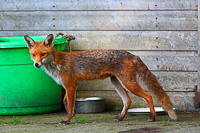 was taken in June 2009, close to my home at
Hermiston which is right in the middle of a conservation area which I
share with badgers, pheasants, squirrels, buzzards and all sorts of
other wildlife. I used the Canon 450D with the 1.4x tele-convertor and
the Canon 300mm f2.8 IS L Lens fitted. It was taken 'hand held' from
inside a dry shelter leaning the rig against the side of the doorway
looking out onto my yard about 60 yards away. It was shot at 672mm field
of view, ISO:800, 1/500sec, f4 and I fired off about 12 single shots
over a five minute period but only managed to achieve 4 shots with
'optimum focus' on her. My idea of optimum focus with the 300mm is the
ability to see the 'hair detail' with the image at full size. I had used
'spot focus' and multiple metering but I was disappointed with my
technique due to the number of out of focus shots. When I say out of
focus the shots up to a certain size, appeared okay but at full size
they were very slightly out of focus. was taken in June 2009, close to my home at
Hermiston which is right in the middle of a conservation area which I
share with badgers, pheasants, squirrels, buzzards and all sorts of
other wildlife. I used the Canon 450D with the 1.4x tele-convertor and
the Canon 300mm f2.8 IS L Lens fitted. It was taken 'hand held' from
inside a dry shelter leaning the rig against the side of the doorway
looking out onto my yard about 60 yards away. It was shot at 672mm field
of view, ISO:800, 1/500sec, f4 and I fired off about 12 single shots
over a five minute period but only managed to achieve 4 shots with
'optimum focus' on her. My idea of optimum focus with the 300mm is the
ability to see the 'hair detail' with the image at full size. I had used
'spot focus' and multiple metering but I was disappointed with my
technique due to the number of out of focus shots. When I say out of
focus the shots up to a certain size, appeared okay but at full size
they were very slightly out of focus.
I visited the zoo that year and tried
out the combination with my monopod and 'hand held' shots, with and
without the 1.4x teleconvertor but I was very disappointed as most of
the images lacked the 'hair detail' focus at full size.
It is very difficult for me
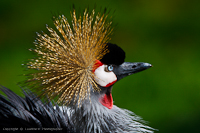 to
assess what the problem was and still is with my
technique...............this is very much a 'work in progress' to
establish how to achieve 'optimum' image quality
with telephoto wildlife photography. The picture of the bird was
achieved 'hand held' at 480mm depth of field, ISO:200, 1/1250sec, f4 and again was
only one of many shots taken that I could say was of acceptable quality.
However, it was shot through very fine nylon mesh fencing and this may
have a bearing on the spot autofocus of the 450D camera as regards the
failed shots? to
assess what the problem was and still is with my
technique...............this is very much a 'work in progress' to
establish how to achieve 'optimum' image quality
with telephoto wildlife photography. The picture of the bird was
achieved 'hand held' at 480mm depth of field, ISO:200, 1/1250sec, f4 and again was
only one of many shots taken that I could say was of acceptable quality.
However, it was shot through very fine nylon mesh fencing and this may
have a bearing on the spot autofocus of the 450D camera as regards the
failed shots?
This image of the bird may seem okay but there is still the hint (very
fine detail) of the nylon mesh, which appears to be behind the bird but is
actually in front of it. The shot was taken with the lens hood as close
to the nylon mesh as possible and the aperture set fairly wide. The
contrast of the lens suffered because of the nylon mesh but I brought it
back in post processing.
I have to say that when the focus is 100%
the image quality from the lens and the 450D is amazing, especially when
you consider that the camera cost me £425. I have learned a few things about
wildlife photography with the 300mm 'native lens' focal range. There
seems to be a limit even with the power of this lens at which it is
capable of resolving 'hair detail' in an image at full size. Coupled
with this and even using image stabilization, wildlife does move even
when you do not expect it; so a high shutter speed is desirable at all
times, especially when the rig is 'hand held' and you are grabbing a
shot that might not remain still. I am now starting to condition myself
to shoot at 1/1200sec or higher (if possible) bearing in mind the
limitations of the camera for achieving image quality at higher ISO
settings.
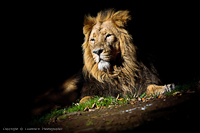 The
450D seems to be able to hack it at ISO:800 and in very good light with
next to no shadows, up to ISO:1600. The
450D seems to be able to hack it at ISO:800 and in very good light with
next to no shadows, up to ISO:1600.
The lion shots were ALL in focus and were taken from a balcony (through
glass)
over looking the caged enclosure, the lion was lit by the sun in a
shaded area. They were captured 'hand held' with the 450D plus the 300m
lens and the first one was at 480mm field of view, ISO:200, 1/1250sec
and f2.8..........the lens held up extremely well for a spot focus f2.8
shot at that distance, which was about 50-60 yards. Even more impressive
is that the images have been cropped in post processing.
Glass can be difficult to shoot through as zoo glass is usually heavily
scratched and very often the light from behind you reflects of the
glass, back into the lens. I usually put the hood front square against
the glass (as much as possible) to prevent backlit reflection and set
the aperture as wide as possible to cut out the scratches. The contrast
of the lens suffered because of the glass but I brought it back in post
processing.
The second lion shot was taken 'hand held' at 480mm field of view,
ISO:200, 1/1200sec and f2.8. I wish that I could claim that the shot was
exactly as you see it but this is not the case.
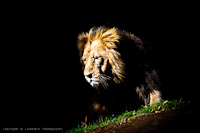 Apart
from cropping, increased saturation and sharpening both the lion images
have had their cage bars removed from behind the subjects in post
processing using the adjustment brush in Adobe Lightroom 3 Software set
to -4 exposure.........no colour has been added. Apart
from cropping, increased saturation and sharpening both the lion images
have had their cage bars removed from behind the subjects in post
processing using the adjustment brush in Adobe Lightroom 3 Software set
to -4 exposure.........no colour has been added.
Lightroom 3 is a very powerful software
package and no matter how good the subjects are in the final image,
sometimes they require additional tweaking such as vignetting applied to
lead the eye onto the main subject. This is not to everyone's taste but
I have included a couple of images with this. The zebra is one example
and it was shot with the 1.4x tele-convertor fitted at 672mm field of
view, ISO:200, 1/400sec and aperture at f4. This was a shot taken
on the monopod and the
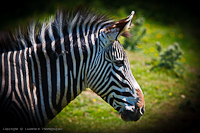 zebra
was 'dead still' at the time.......it is the only reason that I think
the spot autofocus was so good at 1/400sec? zebra
was 'dead still' at the time.......it is the only reason that I think
the spot autofocus was so good at 1/400sec?
This image of the
 fawn
in the clearing was shot with the 1.4x tele-convertor fitted at 672mm
field of view, ISO:200, 1/1250sec and aperture at f4. This again
was a shot taken on the monopod. Once again in Lightroom, I applied vignetting to
darken the corners. fawn
in the clearing was shot with the 1.4x tele-convertor fitted at 672mm
field of view, ISO:200, 1/1250sec and aperture at f4. This again
was a shot taken on the monopod. Once again in Lightroom, I applied vignetting to
darken the corners.
A great deal has been written on the Internet about the autofocus capabilities of Canon DSLR's including the Canon 450D. I have to say that I have never
experienced any difficulty with spot autofocus when using the camera
with my lenses all the way up to 200mm but at 300mm the ball game
changes! I am convinced that most of the 'claimed out of focus shots'
that you read about on the web are more about the 'lack of technique'
especially at 300mm and above, rather than the camera itself. The light
on the subject has a lot to do with it as I find that well lit shots are
usually all spot on (if you will excuse the pun) and in relation to my lion shots, I captured about ten at
f2.8............they were all in focus.
The image of the bear
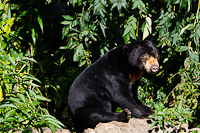 was
captured 'hand held' at 480mm field of view, ISO:200, 1/800sec, f4 and
with only slight cropping, increased saturation and sharpening in post
processing. I did take other images 1/800sec hand held but although they
seemed alright a various sizes, they were ALL slightly blurred at full
size. The little guy was moving around a lot (except for this shot) and
munching on the leaves. Again technique seems to be the culprit but the
next time I visit the zoo, I plan to shoot all my 'hand held' images at
1/1250sec or above to establish if there is a speed/blur pattern...........caused by my working at slower shutter speeds? was
captured 'hand held' at 480mm field of view, ISO:200, 1/800sec, f4 and
with only slight cropping, increased saturation and sharpening in post
processing. I did take other images 1/800sec hand held but although they
seemed alright a various sizes, they were ALL slightly blurred at full
size. The little guy was moving around a lot (except for this shot) and
munching on the leaves. Again technique seems to be the culprit but the
next time I visit the zoo, I plan to shoot all my 'hand held' images at
1/1250sec or above to establish if there is a speed/blur pattern...........caused by my working at slower shutter speeds?
This image of the two seals was shot 'hand held' across the pool at
about 70 yards.
 It
was taken at 672mm field of view, ISO:200, 1/1000sec, f4 with the 1.4x
tele-convertor fitted. There was movement as they were playing in the
water. I have not used 'burst mode' for any of my shots in this
article............it was only one image captured but it worked out very
well. It
was taken at 672mm field of view, ISO:200, 1/1000sec, f4 with the 1.4x
tele-convertor fitted. There was movement as they were playing in the
water. I have not used 'burst mode' for any of my shots in this
article............it was only one image captured but it worked out very
well.
This last image was taken of a 'basking' seal and she did not seem to
mind the camera.
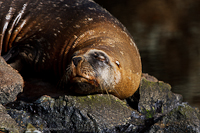 It
was captured 'hand held' at 480mm field of view, ISO:200, 1/1600sec, f4
and with only increased saturation and sharpening in post processing. It
was captured 'hand held' at 480mm field of view, ISO:200, 1/1600sec, f4
and with only increased saturation and sharpening in post processing.
Conclusions
(4th January 2011)
At first I had great difficulty in establishing what was wrong with my technique as I
have only visited the zoo twice with the Canon 450D DSLR and the Canon
300mm f2.8 IS L Lens. I have not taken enough pictures and I have not
changed my style for long enough to conclude a pattern as to why nearly
half my 'full size' images lack that ultimate 'hair splitting' sharpness of the
subject.
For most normal size 'family' prints, virtually all my images deliver
the look and the resolution required but when I push about 50% of them
to full size the 'out of focus' becomes apparent.
During 2010, I persevered with the 450D and the 300mm lens and reached
some interesting conclusions in relation to stationery subjects and
achieving a 'greater' keeper rate for my full size images -
-
GLASS &
MESH - Irrespective of how I set the camera and use the combination,
glass panels and fine wire mesh screens in front of my lens will
impact on my ability to raise my keeper rate for sharp resolution
'full size' images.
-
DISTANCE
+ CENTRE SPOT AF POINT
- The Canon 300mm f2.8 IS L Lens does have certain limitations when
I am hand holding it, even on a monopod or tripod. If a stationery
subject is SMALL in the viewfinder and I am using 'centre spot'
focusing then the distance from the lens seems to play an important
part in achieving that 'hair splitting' focus on a full size image.
I have noticed that larger subjects in my viewfinder have a
dramatically higher keeper rate and this may have something to do
with the actual image area that the spot focus covers. It is
possible that the spot focus AF point 'overlaps smaller subjects'
and autofocus is thrown off by the background or other material
surrounding the subject? I no longer stretch out the reach of the lens and avoid capturing
images that will require 'extensive cropping' in post processing. It
is irrelevant what the image is................my rule of thumb is
that whatever I am spot focusing on, it must be reasonably large and
'clearly visible with resolution' in the viewfinder and therefore
(hopefully) the final image.
-
SPEED/SHUTTER - I now increase the shutter speed relevant to the
size of the subject in the viewfinder and the larger and more
stationery the subject, the slower the shutter speed, especially if
I am using the monopod. In virtually all cases of wildlife
photography with the 450D+300mm lens combo, I now tend to work with
a shutter speed of at least 1/1250sec or above where possible
on all subjects.
-
APERTURE - The aperture and ISO settings of
choice are unfortunately dictated by the distance and the shutter
speed required to capture the subject. If 'hair splitting' focus is
required on full size images, there is no other recourse. On winter
days, dark shadow subjects, heavily overcast skies
and shots taken at dusk, the ISO settings will creep higher and even
at f2.8 lens or f4 when using a 1.4x teleconverter the ISO setting
can reach up to 1600 and beyond. The noise levels start to creep in
but are more predominant in dark shadow images.
-
SENSOR
SIZE - I firmly believe that the sensor size and the number of
pixels in relation to that size plays an important part in achieving
'razor sharp' wildlife images on a 'consistent keeper' basis. The
450D handles very well with the 300mm FX lens but my Canon 5D MK1
works with the lens even better. The 5D has the larger sensor, the
larger pixel size and is native 35mm with the lens............this
appears to deliver a greater number of keepers with 'hair splitting'
focus and also affords (in a greater number of shots) the use of a
lower shutter speeds and lower ISO settings. However, the distance
still plays an important part in 'not stretching' the capability of
the lens range in relation to subject size in the viewfinder.
-
THE CAMERA - It does
appear to play an important part in the ability to 'hand hold' the
300mm FX lens combo or even to use it on a monopod or tripod to
achieve those elusive 'hair splitting' full size images. A 'full
frame' 35mm DSLR seems to offer the ideal solution and perhaps it is
no wonder that the Nikon D3 DSLR has become so popular for wildlife
photography with it's 12 MPixel 'Full Frame' Sensor. The Nikon is a
step up from the Canon 5D MK1 DSLR as it offers a superior AF system
and facilitates the use of higher ISO settings with very little
noise. The whole point of the exercise
was to work out a method of achieving a 'greater' keeper rate for my
full size images. Whatever camera I use, whether it is a full frame
or a 1.6x crop sensor there will be excellent images captured
but also a great deal of frustration with the 'out of focus' ones
and the desire to raise the bar on the keeper rate.
-
THE
300mm LENS - There is no doubt in my mind that for optimum image
performance from a 300mm FX lens, I have to
use it within the limits
of it's capability. 35mm (FX) lenses are designed for 'full frame'
sensors and I submit that if the image has to be 'heavily cropped'
to bring up the subject size then the lens has been stretched beyond
it's capability and a 400mm or 500mm lens should be used. Similarly
the same 'impact' is placed on the lens with a crop sensor camera
which narrows the field of view. I am not saying that a crop sensor
camera or indeed a 'heavily cropped' image cannot deliver an
incredible 'hair splitting' full size image...............I just
believe the keeper rate will be lower. Those 300mm lenses that are
specifically designed for (crop) DX DSLRs and smaller cameras such
as those with micro four thirds sensors may well handle differently
and through the manufacturer's design for those cameras, the keeper
rate might be higher?
Canon 450D V Canon 7D
V Canon 5D MKIII DSLRs
The full capability of my Canon 300mm f2.8 IS L Lens is not achieved
with my Canon 450D DSLR. The Canon 7D DSLR with its lens micro-adjust
system coupled with it's brand new autofocus system and much higher
frame speed is the obvious step up. The 7D in all likelihood would
assist in increasing the 'full size' razor sharp image keeper rate.
I want to replace my current Canon 5D MK1 which I purchased in 2006 and
my Canon 450D
with the next Canon 5D MKIII DSLR (expected in 2011) which 'might be'
very similar in size and weight to my 5D MK1 or the 7D. It is likely to
have the same autofocus and micro-adjust lens focus tuning systems of
the 7D.........although the frame speed rate is likely to be lower? I also expect the new 5D to
have at least a 28Mpixel 'full frame' sensor which I can use for
landscapes, portraits and for wildlife photography with my Canon 300mm f2.8
IS L lens, 1.4x teleconverter and monopod for 'niche' wildlife projects.
I
have some concerns about a future Canon 5D MKIII DSLR.................for
although it will be a 'full frame' sensor the actual pixel size (similar
to a 450D) will be relatively small for a sensor with around 28 MPixels.
I am not sure just how many 'full size image' keepers it will deliver
but I have no choice as I want the camera for landscape photography
before wildlife. In an ideal world, the optimum solution would be
a Canon 5D MKIII and a Canon 7D DSLR.............the Canon 'Pro' 1D
cameras are far to large, heavy and expensive for me.
Specially
Planned 'Niche' Wildlife Projects
So what about the Canon 300mm f2.8 IS L Lens for the zoo, nature
reserves and hill walking.............it really does not make a great
deal of sense unless there is a special project in mind, such as
capturing a pre-planned 'specific subject' or a low light subject when
the image has to 'full size' and the very best. The Canon 300mm f2.8 IS L Lens may be
heavy and awkward to carry with the monopod but when set-up it is a
'blast' to use and the image quality is awesome. For those 'niche'
projects where focal range may be varied, it would make more sense to
balance the 300mm prime lens with a 70-200mm f2.8 IS L Lens.............I
see my ideal wildlife 'gear' set-up in 2011 to include -
-
Lowepro 400AW 'Flipside' Backpack (Flipside for
security)
-
Canon 5D MKIII 'Full Frame' Sensor DSLR
(Hopefully released for the early summer)
-
Canon 70-200mm f2.8 IS L 'Zoom' Lens
-
Canon 300mm f2.8 IS L 'Prime' Lens
-
Canon 1.4x Teleconverter
-
Gitso GM5542
Monopod with a Wimberley Slide Head
________________________________________________________________
Lightweight Solution for Wildlife with Optimum Performance!
If I was
starting out today from scratch and I had not spent so much money on the
Canon 300mm f2.8 IS L Lens there would be open to me a couple of
options. The camera of choice would be more than likely the Canon 7D
DSLR with it's 1.6x crop sensor to provide that extra reach and with
it's great autofocus system with lens focus adjust to hone the camera
and lens for optimum image quality.
Without a doubt, I would select the Canon 300mm f4 IS L 'Prime' Lens
which for the size, weight and the price offers exceptional image
quality. However very close on it's heels is the 'NEW' Canon 70-300mm
f4-f5.6 IS L Lens which 'almost' delivers the same IQ at 300mm and
offers 70mm-300mm focal range on a 'full frame' sensor DSLR and
112mm-480mm field of view on the 7D crop sensor.
The 'Prime' Canon 300mm f4 IS L Lens can be used with a Canon or Kenko
1.4x crop teleconverter which are compatible. However, the Canon
70-300mm f4 IS L Zoom Lens is not compatible with a Canon 1.4x crop
teleconverter. I understand
from the reviews that I have read that the new 1.4x crop Kenko
teleconverter is compatible and autofocus is maintained throughout the
zoom range.
________________________________________________________________
The Social
Experience + Casual Use!
For
casual use like walking about the zoo, nature reserves or hill walking
where you want a small lightweight set-up that is easy to carry and the
'social part' of the experience is just as important as the photography
or the final 'full size' image quality............a small lightweight digital
camera with a 70-300mm IS lens would make more sense.
If you have enjoyed this article - please donate to my
Charity of Choice -
The Sick Kids
Richard Lawrence
Scotland
United Kingdom
Back to Articles Page |








